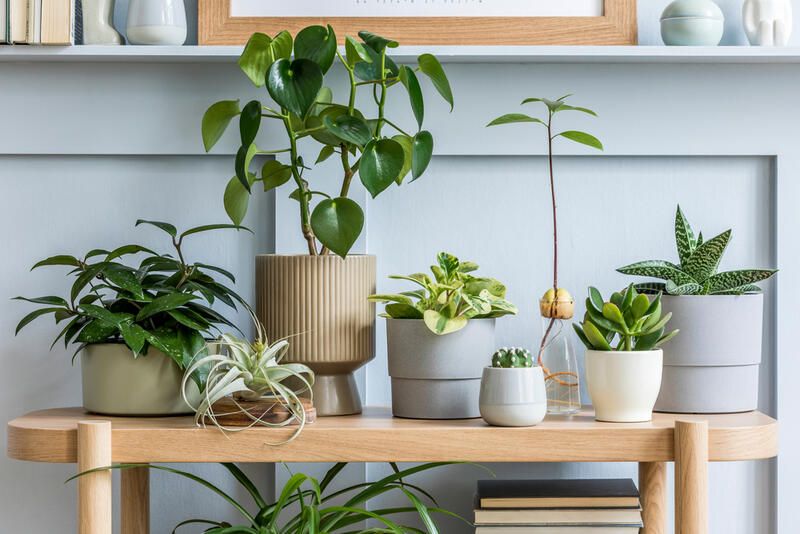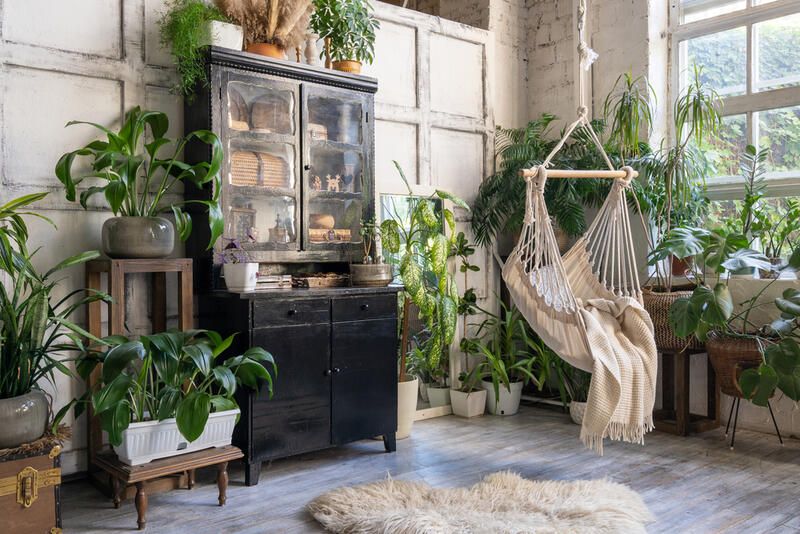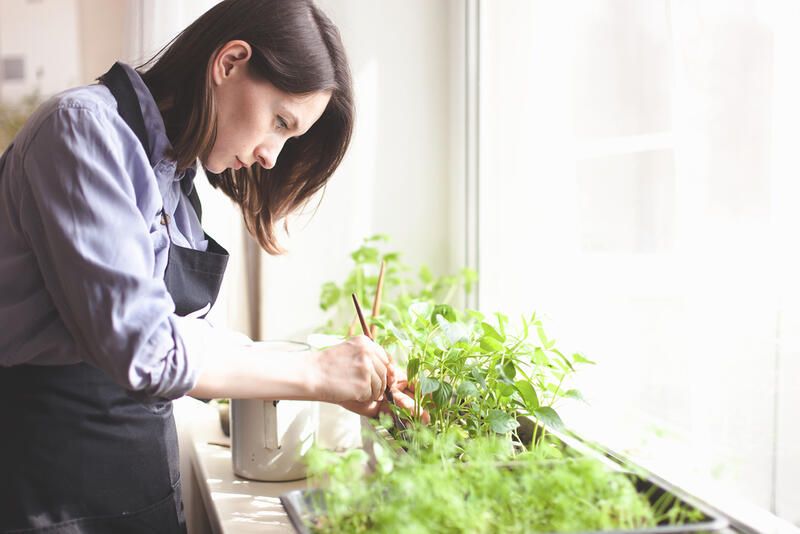
Bringing the Outdoors In: Your Indoor Garden Guide
Published: 27/03/2023 | Updated: 09/09/2023
What's better than a refreshing salad with freshly picked home-grown veggies?


Growing a successful garden is a joyful and satisfying experience, but what if you lack the skill, outdoor space, or the proper outdoor conditions?
Tag along as we walk through the basics of indoor gardens!
You'll learn about the benefits of indoor gardens, and the different types of indoor garden systems, and get tips to help you create your very own functional and stylish indoor garden.
Why You Should Consider an Indoor Garden
Indoor gardens not only improve the aesthetic appeal of your home, but they also provide numerous health benefits.
Growing your herbs and vegetables gives you a source of fresh food while giving you the comfort of knowing what you're feeding your family.
Additionally, Studies have shown that indoor plants can improve air quality, reduce stress levels, and even boost productivity.
1. A Beautiful Home
Going into a room with nice greenery, you can almost instantly feel better and have healthier energy, this shows how greenery has the power to liven up a room, making it feel fresher and more inviting.
And since plants come in different shapes, sizes, and colors, it's no hard task to find ones that complement your space and its current decor and give you the freedom to unleash your artsy side.
For example, if your living room is mostly neutral, you could add a splash of color with a vibrant peace lily or a spider plant.
If you prefer a more eclectic look, you could go for different heights and textures in layers to create a nice indoor jungle.

2. Improved Health
Indoor gardening has numerous benefits that can improve both your physical and mental health. Here are a few examples
Stress Reduction:
Studies have shown that spending time around plants can help reduce stress and anxiety levels. Simply looking at plants can lower blood pressure and improve mood.
Productivity Increase:
Having plants in your workspace can lead to increased productivity and concentration.
This is because plants can help reduce noise levels and create a calmer and more focused environment.
Improved Sleep:
Some houseplants, such as lavender, and jasmine filter the air of toxins, release oxygen, and create a relaxing atmosphere leading to a more restful and relaxed sleep.
3. More Greenery Is Better Air Quality
Indoor plants have been shown to assist in air purification by removing harmful toxins and pollutants.
This is ideal for city homes since the air is typically more polluted.
Many indoor plants can also filter the air of harmful pollutants, like formaldehyde, benzene, and trichloroethylene.
These pollutants are commonly found in home furnishings, cleaning products, and carpets.
According to a NASA study, certain indoor plants, such as spider plants, peace lilies, and bamboo palms, are extremely effective at removing pollutants.
And as a bonus, these plants usually increase the humidity levels making the dry winter months more tolerable.
Best Indoor Garden systems
There are a lot of indoor garden kits available on the market, here are the different indoor gardening systems you're likely to come across in your search for the perfect one for you.

Hydroponic Systems
Hydroponic systems cultivate plants using a water-based growing medium and nutrient-rich water, making them highly efficient and environmentally friendly.
They're also simple to keep and provide a controlled growing environment ideal for growing herbs, vegetables, and even flowers.
Aeroponic Systems
Aeroponic systems use the mist to deliver nutrients to plant roots, making them extremely efficient and effective.
They are also low-maintenance and provide a sterile growing environment, making them ideal for indoor plant growth.
Self-Watering Systems
Self-watering smart garden systems store water in a reservoir and then distribute it to the plants as needed. They're also simple to maintain and ideal for growing a variety of plants.
This makes them the ideal choice for people with a busy schedule or no tolerance for maintenance.
LED Grow Lights:
While it is very likely for an indoor gardening system to come with grow lights attached grow lights are a great addition to any system for growing plants inside.
They are ideal for people without access to natural sunlight since they supply the illumination required for indoor plants to grow and thrive.
Best Plants to Grow In Indoor Gardens
1. Vegetables
Leafy greens: Lettuce, kale, and spinach among other leafy salad greens are very easy to grow indoors with proper care.
Potatoes: While you may need a larger-than-average indoor garden container, it's very possible to grow your own potatoes indoors.
Peppers: peppers are among plants that thrive indoors without hard measures or special conditions, so peppers should be on your radar if you're a beginner.
Tomatoes: Because they can be grown in small containers and do not require staking. Cherry tomatoes and determinate tomatoes are ideal for indoor gardens.

2. Shade And Low Light Plants
Snake Plant: This tough plant can live in almost any environment, including low light.
ZZ Plant: Another hardy option that can survive in low light conditions is the ZZ plant.
Pothos: This trailing plant can tolerate low light and is ideal for hanging baskets.
Spider Plant: A popular choice for indoor gardens, the spider plant can thrive in low light conditions.
3. Herbs
Most Herbs prefer light and warmth to thrive, with the right setup, you can have a culinary herb garden you can use anytime from your kitchen.
Parsley, oregano, dill, mint, thyme, and basil are all herbs you can grow in your indoor garden.
Essential Indoor Plants Care
Finally, to keep your indoor plants thriving, it is essential to regularly monitor them and make sure they're getting what they need as you would with an outdoor garden.
Since the inside of a home is not a very convenient environment for plant growth, you'll need to keep an eye out for the following aspects
Watering
Because every plant has a varied level of watering requirements, it's critical to do your homework.
Generally speaking, it's preferable to submerge rather than overwater your plants because the latter might result in root rot.
Never water without first checking the soil's moisture content, and never leave water sitting in the saucer for too long.

Light Exposure
For healthy growth, most indoor plants need strong, indirect light.
Yet, some species of plants, such as ferns and snake plants, can survive in low light conditions.
Once you've learned about your plants' light exposure needs, make sure to place them in proper locations accordingly so they're exposed to sunlight or indoor LED grow lights.
Humidity
Just as the case is with water and light, different plants also tend to have different humidity needs.
To keep humidity-loving plants in good shape, make sure to spray mist them with water or add a humidifier to the room.
Fertilizing
To ensure that indoor plants receive the nutrients they need to flourish, they should be fertilized regularly.
Use fertilizer or "Plant food" that is suitable for your plants and pay close attention to the directions for better results.
Pruning
Doing regular pruning on your plants will help keep them healthy and looking their best.
It is recommended to trim back any overgrown branches and remove any dead or damaged leaves.
For more expert tips and ideas on gardening, landscaping, and exterior design make sure to visit our blog.
And if you're ready to design the yard of your dreams, check out Shrub Hub's attractive design packages and sign up for the fastest, most affordable, and most efficient landscape design service on the market.
Give our design gallery a look to find your style and book your design consultation today!


